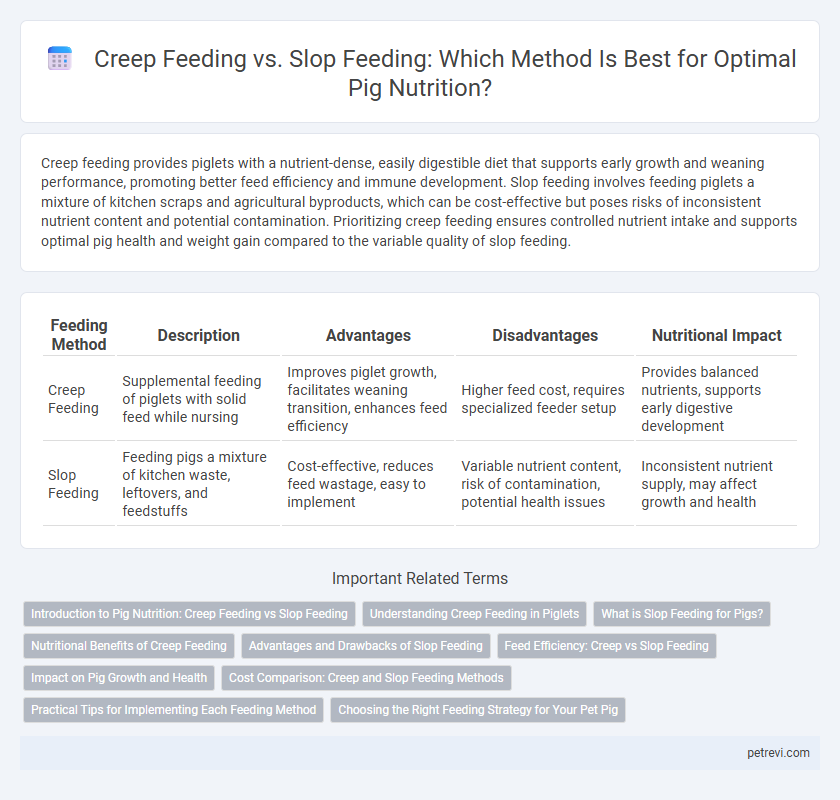Creep feeding provides piglets with a nutrient-dense, easily digestible diet that supports early growth and weaning performance, promoting better feed efficiency and immune development. Slop feeding involves feeding piglets a mixture of kitchen scraps and agricultural byproducts, which can be cost-effective but poses risks of inconsistent nutrient content and potential contamination. Prioritizing creep feeding ensures controlled nutrient intake and supports optimal pig health and weight gain compared to the variable quality of slop feeding.
Table of Comparison
| Feeding Method | Description | Advantages | Disadvantages | Nutritional Impact |
|---|---|---|---|---|
| Creep Feeding | Supplemental feeding of piglets with solid feed while nursing | Improves piglet growth, facilitates weaning transition, enhances feed efficiency | Higher feed cost, requires specialized feeder setup | Provides balanced nutrients, supports early digestive development |
| Slop Feeding | Feeding pigs a mixture of kitchen waste, leftovers, and feedstuffs | Cost-effective, reduces feed wastage, easy to implement | Variable nutrient content, risk of contamination, potential health issues | Inconsistent nutrient supply, may affect growth and health |
Introduction to Pig Nutrition: Creep Feeding vs Slop Feeding
Creep feeding provides piglets with nutrient-dense feed during the nursing phase, promoting early growth and smoother weaning transitions by supplementing sow milk. Slop feeding, involving a mixture of kitchen and farm waste, offers a cost-effective but less controlled nutritional source that can vary widely in quality and digestibility. Optimal pig nutrition relies on balancing feed composition, with creep feeding ensuring precise nutrient intake for developing piglets while slop feeding requires careful management to avoid health risks and nutritional deficiencies.
Understanding Creep Feeding in Piglets
Creep feeding provides piglets with a highly digestible, nutrient-dense diet during the early weaning period, promoting optimal growth and reducing stress associated with transition from sow's milk. By offering a specialized feed in a designated area, piglets learn to consume solid feed while minimizing competition with older pigs. This targeted nutritional strategy enhances gut development and immune function, resulting in healthier, more robust piglets compared to traditional slop feeding methods.
What is Slop Feeding for Pigs?
Slop feeding for pigs involves providing a mixture of kitchen scraps, grains, and water as a supplement to their regular diet, promoting efficient nutrient recycling and reducing feed costs. This practice enhances pig growth by offering a varied nutrient profile, including carbohydrates, proteins, and minerals, while supporting gut health through fermentation of organic matter. Proper management is crucial to prevent spoilage and maintain hygiene, ensuring optimal pig nutrition and minimizing the risk of disease.
Nutritional Benefits of Creep Feeding
Creep feeding provides piglets with early access to highly digestible, nutrient-dense feed, enhancing weaning weights and overall growth performance. It supplies essential proteins, vitamins, and minerals that support immune function and development during the critical pre-weaning phase. Compared to slop feeding, creep feeding offers consistent nutrient intake and improved feed efficiency, promoting healthier and more uniform piglet populations.
Advantages and Drawbacks of Slop Feeding
Slop feeding for pig nutrition offers advantages such as cost-effectiveness, as it utilizes kitchen and agricultural waste, reducing feed expenses and minimizing waste disposal issues. It can improve feed palatability and encourage feed intake, promoting growth in young pigs. However, drawbacks include the risk of nutrient imbalances, potential contamination with pathogens, and difficulties in maintaining consistent feed quality and hygiene standards.
Feed Efficiency: Creep vs Slop Feeding
Creep feeding in pig nutrition enhances feed efficiency by providing piglets with nutrient-dense, easily digestible feed tailored to their growth needs. Slop feeding typically results in lower feed efficiency due to feed spoilage, inconsistent nutrient intake, and higher waste from unconsumed leftovers. Optimizing creep feeding strategies can significantly improve feed conversion ratios and promote healthier, faster-growing piglets compared to slop feeding.
Impact on Pig Growth and Health
Creep feeding significantly enhances piglet growth by providing nutrient-dense feed during the lactation period, supporting muscle development and early weight gain. Slop feeding, while cost-effective, often lacks consistent nutrient profiles, which can lead to slower growth rates and increased risk of digestive issues in pigs. Optimal pig health and performance are achieved through creep feeding due to its controlled nutrient delivery, promoting stronger immune function and better feed conversion ratios.
Cost Comparison: Creep and Slop Feeding Methods
Creep feeding generally incurs higher costs due to the specialized feed composition and equipment required for young pigs, while slop feeding leverages food waste and is typically more economical but may involve additional sanitation expenses. Creep feeding offers precise nutrient delivery promoting optimal growth rates, potentially reducing overall fattening time and feed conversion ratio costs compared to slop feeding. Cost efficiency depends on farm size, feed availability, and management practices, with creep feeding favored in high-performance operations despite greater upfront investment.
Practical Tips for Implementing Each Feeding Method
Creep feeding enhances piglet growth by providing high-quality, easily digestible feed in a separate feeder, ensuring constant access and minimizing feed wastage through careful feeder placement and regular cleaning. Slop feeding involves mixing kitchen scraps or by-products, requiring strict hygiene practices and consistent feed composition to prevent nutrient imbalances and contamination. Monitoring piglet health and adjusting feeding amounts based on growth rates are essential for optimizing nutrition and preventing digestive issues in both methods.
Choosing the Right Feeding Strategy for Your Pet Pig
Creep feeding provides young piglets with nutrient-dense, easily digestible solid feed, promoting early growth and easing the weaning transition. Slop feeding, consisting of a mixture of kitchen scraps and feed, offers a cost-effective and palatable option but may lack balanced nutrition and pose hygiene risks. Selecting the right strategy depends on factors like piglet age, nutritional goals, and management practices to ensure optimal health and development.
Creep feeding vs Slop feeding for Pig nutrition Infographic

 petrevi.com
petrevi.com